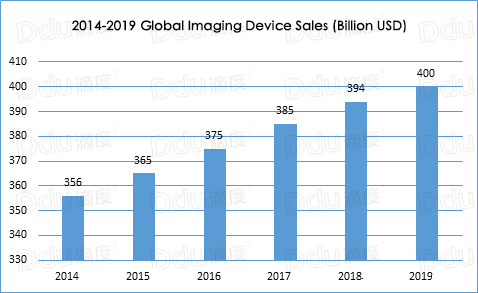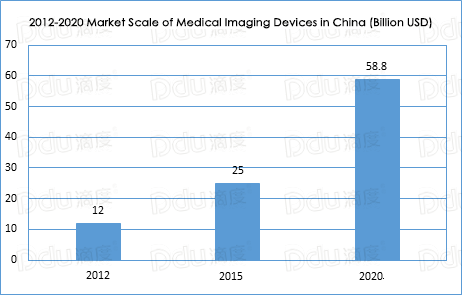China’s Import and Export Report on Medical Imaging Devices
August 8, 2017
Source: Ddu
 1,724
1,724

With the rapid development of modern computer and signal integration technology, construction of digitalization in medical imaging devices has become a new trend. CR / DR, multi-slice spiral CT, Magnetic Resonance Imaging (MRI) and Positron Emission Tomography (PET) have been applied in clinical practices and play an increasingly important role.

In the global market of medical devices, medical imaging devices account for 10% of the shares and with people’s rising awareness of the prevention of chronic diseases, the imaging device market is expanding. Global sales of imaging devices in 2016 totaled at 37.5 billion USD and it is estimated to reach 40 billion USD in 2019.
Today, Ddu, leading global pharmaceutical & medical device B2B online platform, brings you the import and export report of imaging devices in China.
China is fourth largest in the global medical imaging device market.
At present, the sales of medical imaging devices in China totals at 10 billion USD in the global market and has become the fourth largest market of medical imaging devices, only ranking behind the United States, Japan and Germany.
Considering the huge market in China, manufacturers around the world have begun to substantially expand and invest in the Chinese market.

In 2012, medical imaging device sales in China totaled at 1.2 billion USD. With the growing population, increased consumption and technological innovation, the medical imaging device market is expected to expand and sales of medical imaging devices in China is estimated to total 5.88 billion USD in 2020.
China mainly imports medical imaging devices from the United States, Japan and Germany.
As one of the high-end importers of medical devices, China has an ever growing demand for these devices. After the start of the 21st century, giants of the foreign medical imaging device market began to export their products to China, who in turn mainly imported imaging devices from the United States, Japan and Germany.
Among them GE, Siemens, Philips, Hitachi, Toshiba and Shimadzu and six other foreign-funded enterprises now make up more than 80% of the market share. Mindray, Beijing Wandong Medical and Neusoft, the three largest companies of medical imaging devices in China, accounts for about 10% of the market.

Toshiba, as one of the world's leading manufacturers of imaging devices and after a century of development, is now specializing in CTs, X-ray machines, MRIs, ultrasonic imaging and CL( Bio-chemical Analyzers).
GE is well-known as the GPS for global medical imaging because of its MRI.
Siemens is one of the biggest technological suppliers in the global medical industry and also a pioneer in medical imaging, laboratory diagnoses and medical ITs.
These three companies can essentially meet the demands of companies in China for high-end medical imaging devices.
Computed Tomography (CT) is the main Chinese export product.
Recent years have witnessed a rapid growth of demand for medical imaging, which objectively contributes to the development of the medical imaging device industry in China.
During this development process, local manufacturers of medical imaging devices such as Mindray, Wandong Medical and Neusoft are making a name for themselves and are becoming more popular with foreign companies.

According to the chart above, the United States, Japan and France were China’s main export destinations in 2015 with an export volume of 83.7497 million USD, 25.038 million USD and 24.70 million USD respectively.
Enhancement of collaboration on science research
As the fourth biggest market of medical imaging devices around the world, China will be greatly influenced by the influx of foreign brands.
Ddu suggests that Chinese companies should collaborate with domestic science academia and apply national research projects to the industry. This will result in complementary advantages and ensure the optimum use of resources.
Chinese companies should strengthen their horizontal links, form alliances of intellectual property and share patent rights. Accumulating all these technical advantages and expanding production capacity to jointly increase the overall competence of the industry and, as a result, gain command of the medical imaging device market.
What’s more, clearer imaging and earlier diagnoses will become the trend in the development of medical imaging device research, thus it may be wise to take this into consideration when setting goals for product development.
This article is from DduNews, only for non-commercial use and reproduction. Please indicate the source when distributed.
For more information, please subscribe to the Ddu WeChat account.

Read more on
- 【EXPERT Q&A】What are the regulations and requirements for exporting medical devices to the European Union? September 5, 2023
- 【EXPERT Q&A】What is the procedure for registering medical devices for the Russian market? August 22, 2023
- Things to Know before Buying Newborn Baby Incubators March 31, 2022
- China’s Import and Export Market Report of Vitamins August 26, 2021
- China’s Import and Export Market Report of Rheumatoid Arthritis Drugs August 26, 2021
your submission has already been received.
OK
Subscribe
Please enter a valid Email address!
Submit
The most relevant industry news & insight will be sent to you every two weeks.



